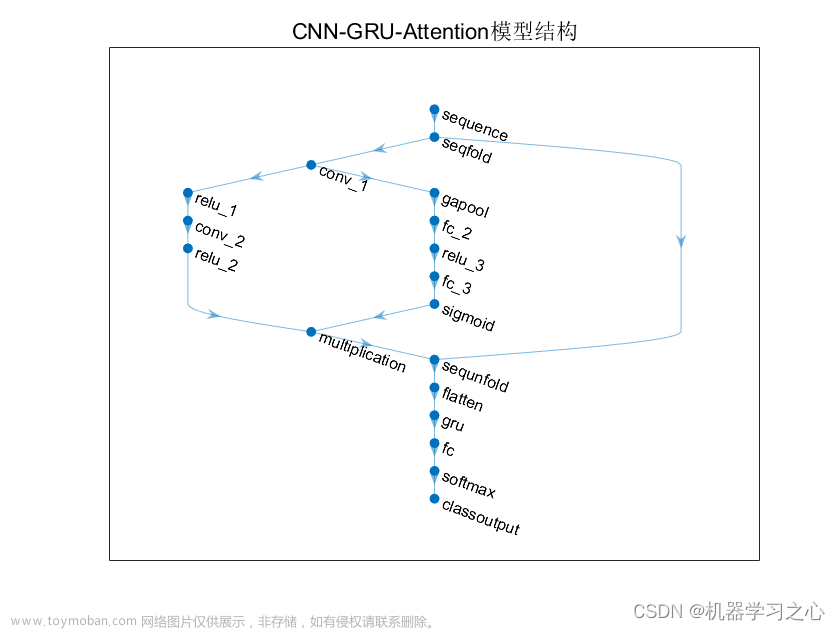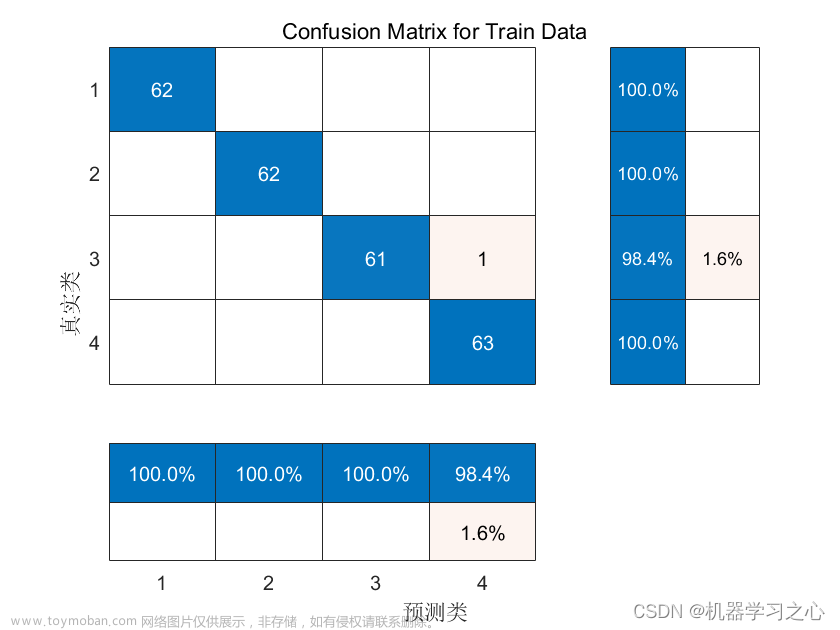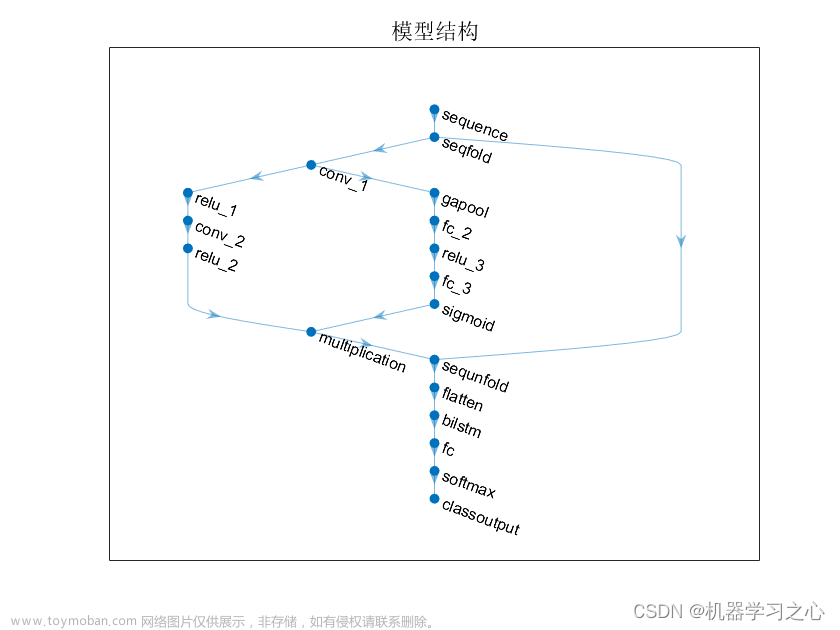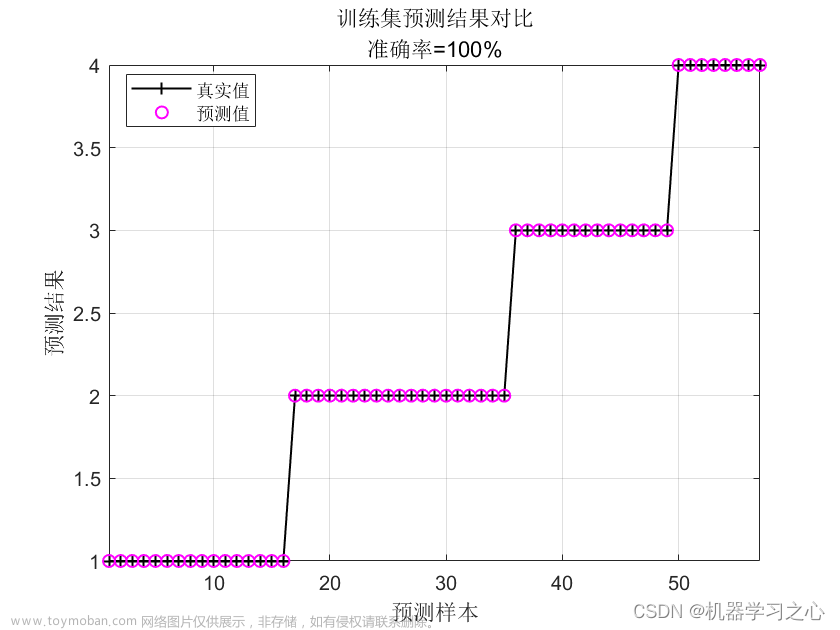分类预测 | MATLAB实现SCNGO-CNN-LSTM-Attention数据分类预测
分类效果


基本描述
1.SCNGO-CNN-LSTM-Attention数据分类预测程序,改进算法,融合正余弦和折射反向学习的北方苍鹰优化算法;
2.程序平台:无Attention适用于MATLAB 2020版及以上版本;融合Attention要求Matlab2023版以上;
3.基于融合正余弦和折射反向学习的北方苍鹰优化算法(SCNGO)、卷积神经网络(CNN)和长短期记忆网络(LSTM)融合注意力机制的数据分类预测程序;
北方苍鹰优化算法(Northern Goshawk Optimization,NGO)由MOHAMMAD DEHGHANI等人于2022年提出,该算法,该算法模拟了北方苍鹰捕猎过程(猎物识别和攻击、追逐及逃生)。
改进策略参照麻雀优化算法,改进点如下:
①采用折射反向学习策略初始化北方苍鹰算法个体,基本思想是通过计算当前解的反向解来扩大搜索范围,借此找出给定问题更好的备选解;
②采用正余弦策略替换原始苍鹰算法的勘察阶段的位置更新公式;
③对正余弦策略的步长搜索因子进行改进;原始步长搜索因子呈线性递减趋势,不利于进一步平衡北方苍鹰算法的全局搜索和局部开发能力。
程序语言为matlab,程序可出分类效果图,迭代优化图,混淆矩阵图;精确度、召回率、精确率、F1分数等评价指标。
4.通过SCNGO优化算法优化学习率、卷积核大小、神经元个数,这3个关键参数,以测试集精度最高为目标函数
4.绘制:损失、精度迭代变化极坐标图;测试对比散点图、混淆矩阵图;适应度曲线;展示:精确度、召回率、精确率、F1分数等评价指标。
5.适用领域:
适用于各种数据分类场景,如滚动轴承故障、变压器油气故障、电力系统输电线路故障区域、绝缘子、配网、电能质量扰动,等领域的识别、诊断和分类。
使用便捷:
直接使用EXCEL表格导入数据,无需大幅修改程序。内部有详细注释,易于理解。文章来源:https://www.toymoban.com/news/detail-666012.html
程序设计
- 完整程序和数据获取方式:私信博主回复MATLAB实现SCNGO-CNN-LSTM-Attention数据分类预测;
% The Whale Optimization Algorithm
function [Best_Cost,Best_pos,curve]=WOA(pop,Max_iter,lb,ub,dim,fobj)
% initialize position vector and score for the leader
Best_pos=zeros(1,dim);
Best_Cost=inf; %change this to -inf for maximization problems
%Initialize the positions of search agents
Positions=initialization(pop,dim,ub,lb);
curve=zeros(1,Max_iter);
t=0;% Loop counter
% Main loop
while t<Max_iter
for i=1:size(Positions,1)
% Return back the search agents that go beyond the boundaries of the search space
Flag4ub=Positions(i,:)>ub;
Flag4lb=Positions(i,:)<lb;
Positions(i,:)=(Positions(i,:).*(~(Flag4ub+Flag4lb)))+ub.*Flag4ub+lb.*Flag4lb;
% Calculate objective function for each search agent
fitness=fobj(Positions(i,:));
% Update the leader
if fitness<Best_Cost % Change this to > for maximization problem
Best_Cost=fitness; % Update alpha
Best_pos=Positions(i,:);
end
end
a=2-t*((2)/Max_iter); % a decreases linearly fron 2 to 0 in Eq. (2.3)
% a2 linearly dicreases from -1 to -2 to calculate t in Eq. (3.12)
a2=-1+t*((-1)/Max_iter);
% Update the Position of search agents
for i=1:size(Positions,1)
r1=rand(); % r1 is a random number in [0,1]
r2=rand(); % r2 is a random number in [0,1]
A=2*a*r1-a; % Eq. (2.3) in the paper
C=2*r2; % Eq. (2.4) in the paper
b=1; % parameters in Eq. (2.5)
l=(a2-1)*rand+1; % parameters in Eq. (2.5)
p = rand(); % p in Eq. (2.6)
for j=1:size(Positions,2)
if p<0.5
if abs(A)>=1
rand_leader_index = floor(pop*rand()+1);
X_rand = Positions(rand_leader_index, :);
D_X_rand=abs(C*X_rand(j)-Positions(i,j)); % Eq. (2.7)
Positions(i,j)=X_rand(j)-A*D_X_rand; % Eq. (2.8)
elseif abs(A)<1
D_Leader=abs(C*Best_pos(j)-Positions(i,j)); % Eq. (2.1)
Positions(i,j)=Best_pos(j)-A*D_Leader; % Eq. (2.2)
end
elseif p>=0.5
distance2Leader=abs(Best_pos(j)-Positions(i,j));
% Eq. (2.5)
Positions(i,j)=distance2Leader*exp(b.*l).*cos(l.*2*pi)+Best_pos(j);
end
end
end
t=t+1;
curve(t)=Best_Cost;
[t Best_Cost]
end
参考资料
[1] https://blog.csdn.net/kjm13182345320/article/details/129036772?spm=1001.2014.3001.5502
[2] https://blog.csdn.net/kjm13182345320/article/details/128690229文章来源地址https://www.toymoban.com/news/detail-666012.html
到了这里,关于分类预测 | MATLAB实现SCNGO-CNN-LSTM-Attention数据分类预测的文章就介绍完了。如果您还想了解更多内容,请在右上角搜索TOY模板网以前的文章或继续浏览下面的相关文章,希望大家以后多多支持TOY模板网!














